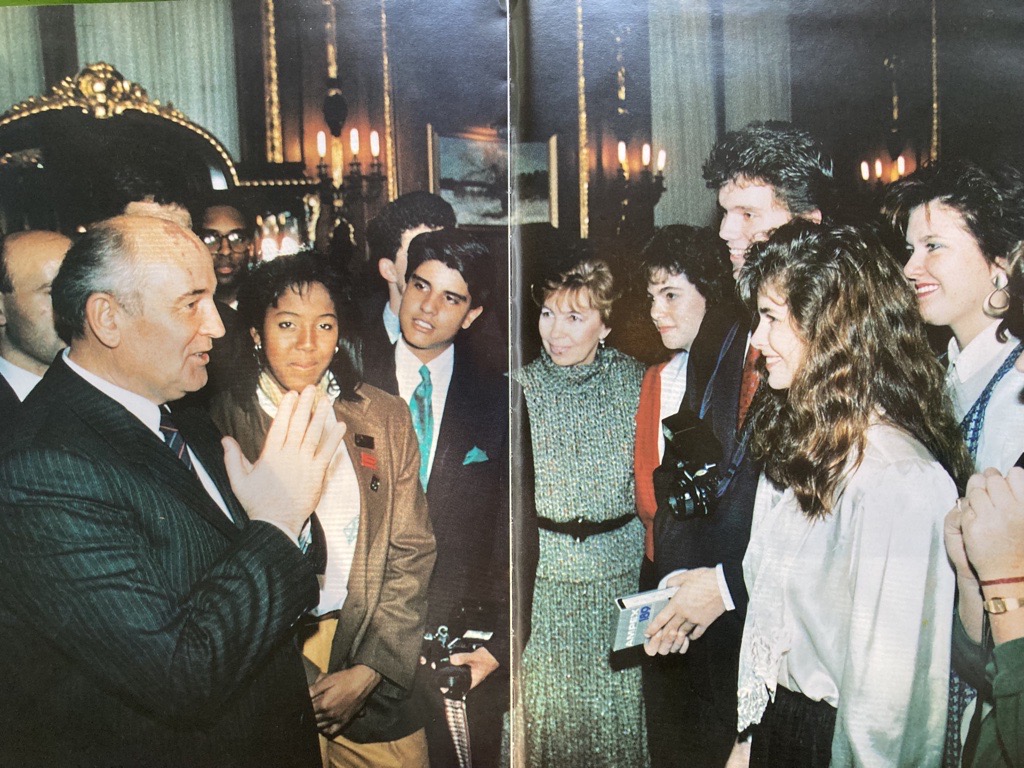Direct Connection ultimately became a youth-led coalition of 60 American and Soviet students coming together to call for peace. Funded by the Close-Up Foundation, we had a week-long retreat in Helsinki, Finland (neutral ground) where Michael Doyle, author of How to Make Meetings Work and inventor of flipchart brainstorming, volunteered his time to facilitate our mini-summit to come up with peace proposals to share with our leaders. It was intense and difficult at times, at one point with the Soviet students walking out and accusing Michael Doyle of being sent by the CIA to sabotage our meetings! The Americans, Soviets, and a handful of Finnish students worked through it, including a tense overnight train ride from Leningrad (now St. Petersburg) to Moscow where we hammered out our final disagreements, and came out with joint recommendations for peace between our countries.
We successfully arranged meetings with President Ronald Reagan at the White House and Soviet General Secretary Gorbachev at the Kremlin, both of whom we meet twice as the peace process unfolded. For President Reagan, the affair was protocol-driven and felt like a nicey-nicey. Michael Gorbachev met with us for more than an hour, was deeply engaged in the suggestions we were making, and shared in the press conference during the Strategic Arms Reduction Treaty talks, about his experience in meeting with us young people. He was looking to the future and saw great promise in peace.
Michael Gorbachev seized the moment to create peace.
Some take-away reflections, large and small:
- The globe needs more leaders like Michael Gorbachev, looking to the future. The devastating war in Ukraine has roots in Putin’s obsession with the past. Our polarized politics in the U.S. has us constantly relitigating old policies and arguments instead of considering the global nature of change and opportunity that could be possible for humanity.
- Flip charts (and other facilitator tools we take for granted) don’t always work cross-culturally. I had an experience in my local community trying to use a flipchart for brainstorming, a practice we do all the time in nonprofits, and nearly had a riot on my hands. Building that cultural understanding is an ongoing life journey and critical for nonprofit organizations, including Maryland Nonprofits.
- Art matters. One of the big disagreements between the Soviet and American students was whether we should sing a song that we had jointly written about peace. The Americans didn’t think singing a song was conducive to a serious meeting about our proposals. Ultimately, it was their country and their leader, so we compromised to sing the song with Gorbachev but not with Reagan. We were coming to the end of a relatively brief meeting with Gorbachev when we said, wait, we also have a song to sing, which we did. That opened his heart and also Raisa’s, and they stayed another hour talking with our group!
- First ladies and gentlemen can be great connections for nonprofits. We got the meeting with Gorbachev through a connection with his wife, Raisa. We then utilized the confirmation of the Gorbachev meeting to leverage our asks with the White House and United Nations.
- Use a photo-op to the max. Our first meeting with President Reagan was just supposed to be a photo op, and there was no guarantee of a second meeting with the full delegation of Soviet students (who all came to DC during the START treaty negotiations). When I shook President Reagan’s hand for the photo, I asked him if he would meet with our whole delegation. Photo-ops are not supposed to have any real dialogue, but what happened was, he said yes! He turned to an aide and said “they’re on the schedule, right?” It may be because I was a naïve student that I got away with that, but it’s worth a try!
- Youth leadership can be substantive and can make history. We have seen that with the climate change movement. We needed adults to help us get organized, raise the funds, and point us in the right direction. Nonprofits provide the important structure to underpin youth leadership, and then youth can really shine.
- Managing change matters. A bold new vision can be too bold for where your people are, something that pops up in my own leadership as a constant push/pull. I tend to be a visionary, but visions must be shared among a critical mass of people. Ultimately, Gorbachev’s vision alone wasn’t able to overcome the headwinds among the Soviet people.
- The peace movement needs revitalization. I felt a strong sense of vacuum when the war in Ukraine broke out, and I noticed that we didn’t really have a visible global peace movement anymore. I bet there are youth leaders that are out there, ready to organize in ways our generation couldn’t even dream of!
Thank you, Michael Gorbachev, for being the bold visionary that brought down the Berlin Wall, freed the people of Eastern Europe and the former Soviet republics, and negotiated peace between the superpowers. Thank you to the nonprofits that made these experiences possible for me and for the many amazing people I met along the way.


